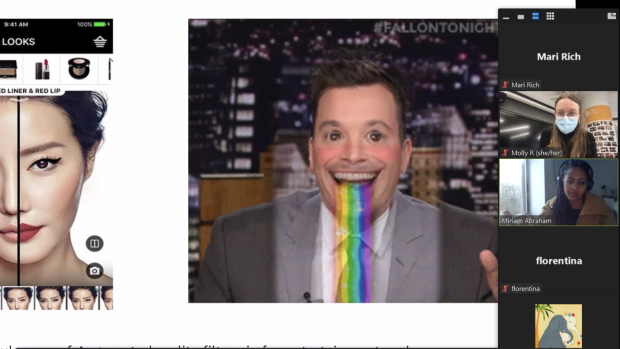Design Week 2022: Creating a more equitable reality

A screenshot of the virtual workshop led by Miriam Hillawi Abraham, multi-disciplinary designer and artist
With more than half of the world’s population currently living in urban areas, and that figure projected to increase to 80% by 2050, NYU Tandon’s annual Design Week, run by the Design Lab @ NYU Tandon MakerSpace, took on a timely theme: how might we reimagine cities to be more equitable, inclusive, and human-centered?
The week’s events were planned with an overarching ideal in mind–that engineers, architects, urban planners, designers, and inhabitants must come together to create holistic, real-life solutions across all scales in order to develop the urban spaces of the future.
Remixing Reality
AR Workshop with Miriam Hillawi
Miriam Hillawi Abraham, a multidisciplinary designer from Addis Ababa, Ethiopia, kicked things off on Monday, February 14, with an interactive workshop that introduced users to Spark AR, a platform that allows users to create augmented reality effects for the cameras on their mobile phones, and Blender, which provides free technical and creative production resources so anyone can create 3D, computer-generated content.
While getting the hang of the tech involved was fun for attendees, Abraham, who was one of this year’s presenters at the World Around Summit at the Guggenheim Museum, pointed out that AR has serious applications in the urban realm, from wayfinding to construction-site safety. Her own area of focus revolves around issues of social justice. As a form of emerging media, AR can provide a method of experiencing and conserving historical sites and artifacts in a way that is critical of their past and thoughtful about their current or intended use, she has said. A neighborhood whose cultural roots have been erased through gentrification could reclaim its history and educate visitors via an AR experience that highlights important sites and events from the past, for example, or a potentially offensive feature (such as a Confederate monument) could be modified or hidden behind a virtual barrier.
A recent recipient of grants from the Gray Area Foundation for the Arts and the Graham Foundation, Abraham encouraged attendees to think of AR as a worldbuilding tool, with the caveat that those worlds should support positive, inclusive experiences; foster creativity; and not just augment but elevate our current reality.
“The workshop provided a lot of practical know-how,” Florentina Sergiou, a Tandon student who is earning a master’s degree in Management of Technology and working at the MakerSpace, said. “But while anyone can learn to use Blender and Spark AR, Miriam helped us see the vast possibilities of leveraging those platforms to envision a better world and do real social good.”

“Design Week is a huge part of the year at the Design Lab @ NYU MakerSpace,” said Molly Ritmiller, the Design Lab’s manager “It is amazing to have the opportunity to connect students to new ideas, design thinking tools, and industry professionals through all of our events. We were honored to have Miriam Hillawi bring her experience and expertise to Design Week to teach us how to think critically about the role AR and VR technologies can play in connecting communities to urban histories and futures, and to share the basics of how to use these technologies with us.”
Associate Professor Semiha Ergan, who oversees Tandon’s Building Informatics and Visualization Lab (biLAB), has a wide-ranging perspective on how augmented and virtual reality can aid in the transition to more inclusive, resilient, efficient, and liveable urban areas. “Cities are so much more than just their buildings,” she says. “Planned well, they’re incubators for interaction, talent, ambition, and innovation, so I’m definitely in favor of any platforms that encourage human-centered design and facilitate that incubation.”
More on Design Week 2022:




